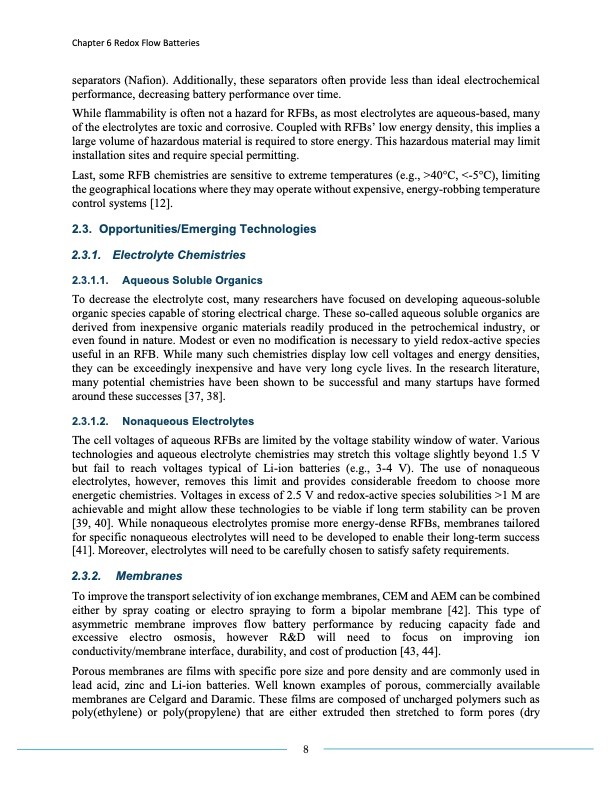
PDF Publication Title:
Text from PDF Page: 008
Chapter 6 Redox Flow Batteries separators (Nafion). Additionally, these separators often provide less than ideal electrochemical performance, decreasing battery performance over time. While flammability is often not a hazard for RFBs, as most electrolytes are aqueous-based, many of the electrolytes are toxic and corrosive. Coupled with RFBs’ low energy density, this implies a large volume of hazardous material is required to store energy. This hazardous material may limit installation sites and require special permitting. Last, some RFB chemistries are sensitive to extreme temperatures (e.g., >40°C, <-5°C), limiting the geographical locations where they may operate without expensive, energy-robbing temperature control systems [12]. 2.3. Opportunities/Emerging Technologies 2.3.1. Electrolyte Chemistries 2.3.1.1. Aqueous Soluble Organics To decrease the electrolyte cost, many researchers have focused on developing aqueous-soluble organic species capable of storing electrical charge. These so-called aqueous soluble organics are derived from inexpensive organic materials readily produced in the petrochemical industry, or even found in nature. Modest or even no modification is necessary to yield redox-active species useful in an RFB. While many such chemistries display low cell voltages and energy densities, they can be exceedingly inexpensive and have very long cycle lives. In the research literature, many potential chemistries have been shown to be successful and many startups have formed around these successes [37, 38]. 2.3.1.2. Nonaqueous Electrolytes The cell voltages of aqueous RFBs are limited by the voltage stability window of water. Various technologies and aqueous electrolyte chemistries may stretch this voltage slightly beyond 1.5 V but fail to reach voltages typical of Li-ion batteries (e.g., 3-4 V). The use of nonaqueous electrolytes, however, removes this limit and provides considerable freedom to choose more energetic chemistries. Voltages in excess of 2.5 V and redox-active species solubilities >1 M are achievable and might allow these technologies to be viable if long term stability can be proven [39, 40]. While nonaqueous electrolytes promise more energy-dense RFBs, membranes tailored for specific nonaqueous electrolytes will need to be developed to enable their long-term success [41]. Moreover, electrolytes will need to be carefully chosen to satisfy safety requirements. 2.3.2. Membranes To improve the transport selectivity of ion exchange membranes, CEM and AEM can be combined either by spray coating or electro spraying to form a bipolar membrane [42]. This type of asymmetric membrane improves flow battery performance by reducing capacity fade and excessive electro osmosis, however R&D will need to focus on improving ion conductivity/membrane interface, durability, and cost of production [43, 44]. Porous membranes are films with specific pore size and pore density and are commonly used in lead acid, zinc and Li-ion batteries. Well known examples of porous, commercially available membranes are Celgard and Daramic. These films are composed of uncharged polymers such as poly(ethylene) or poly(propylene) that are either extruded then stretched to form pores (dry 8PDF Image | REDOX FLOW BATTERIES Chapter 6

PDF Search Title:
REDOX FLOW BATTERIES Chapter 6Original File Name Searched:
ESHB_Ch6_RedoxFlow_Small.pdfDIY PDF Search: Google It | Yahoo | Bing
Salgenx Redox Flow Battery Technology: Salt water flow battery technology with low cost and great energy density that can be used for power storage and thermal storage. Let us de-risk your production using our license. Our aqueous flow battery is less cost than Tesla Megapack and available faster. Redox flow battery. No membrane needed like with Vanadium, or Bromine. Salgenx flow battery
| CONTACT TEL: 608-238-6001 Email: greg@salgenx.com | RSS | AMP |